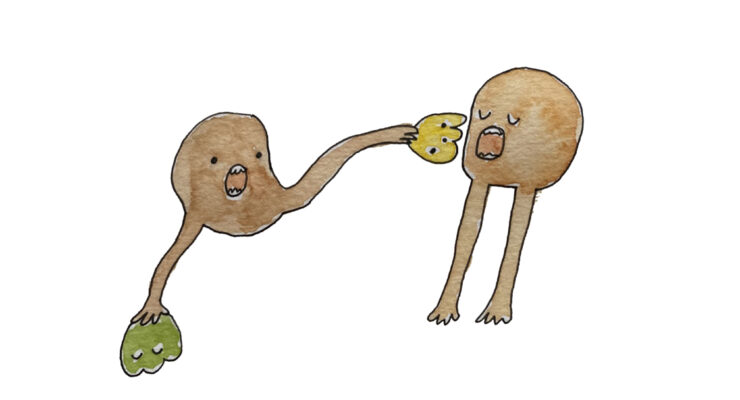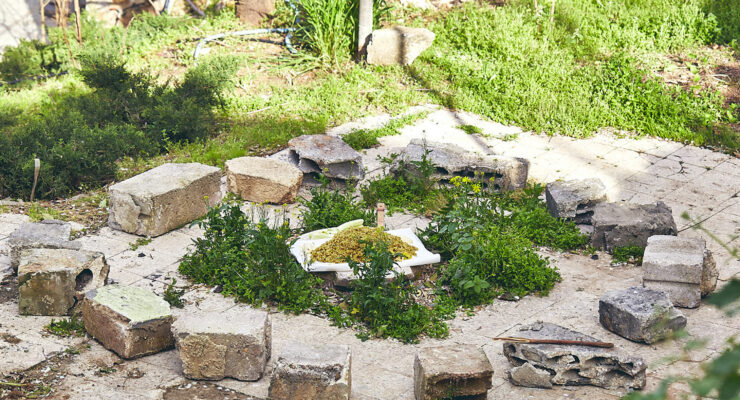Autodîneur
The DIFD interviewed our Scotland correspondent Steph Marsden about how she used her lockdown time to expand on a project about individual eating, with your computer. Autodîneur is a computer-generated guide to an exploratory eating experience. Each time you visit you receive a new set of instructions to follow for a new kind of meal. The instructions help you use all your faculties to get messily in touch with your food.
September 2020 – Scotland
How did the project start? Was it something you had envisaged prior to the lockdown or did it emerge from the situation?
Towards the end of last year, I created a workshop on fermentation and feminism entitled “Bubble Bubble”, in response to a brief by the CCA, Glasgow about the rituals of food practices and food preservation. It was at this time I started to think about the potential of playing around with the everyday rituals of how we eat, and also how these are embedded within our ideas of cultural appropriateness. I was reflecting upon how we hand over autonomy to algorithms on a daily basis to decide what music we listen to, what news we follow and whose opinions we listen to. But when we consider food and robots, we usually think of technologies that prepare, pack or distribute our food. Rarely do we entrust them with how we approach the rituals of dining or eating. I had been following Harry Josephine Giles’ work on Twitter for a while and in particular, their project “Autoflâneur”, a playful Twitter bot that acts as a guide to exploring a city, really resonated with me. So I got in touch with them to enquire about a collaboration. Autodîneur became our response, a procedurally-generated guide for an eating experience. Autodîneur is also food poetry, recombining words we associate with eating experiences to create new contexts and dialogues.
What were the challenges of working collaboratively during lockdown?
The project was originally devised to be used as a tool to lead live events and, initially, I envisaged using canned or preserved food for the first event. Harry Josephine and I had also planned to spend a day prototyping collaboratively in person, so I could learn how to use the software. However, by this stage we were firmly in lockdown, so we reflected upon how Autodîneur could be best used by people at home, or possibly virtually with friends or family. This also reinforced the notion that the programme should not dictate what food or ingredients should be used, as availability and access to food is different for everyone depending on their location.
“Rarely do we entrust robots with how we approach the rituals of dining or eating”
I don’t want to speak for Harry Josie, but I know I certainly found it challenging to juggle this project and other work commitments during a time that has been difficult both personally and politically. Whilst working on the project, I was also working within a community-owned greengrocer as a key worker. But it was nice to create something playful, fun, and a little light-hearted!
During this time I had also become very fond of the work of Glasgow based illustrator Kaitlin Mechan, who had started illustrating life and food practices within lockdown and was a perfect fit to illustrate our quirky little food and technology project!
What were the principles that guided the project?
We made Autodîneur to be:
- Gently provocative, but still safe. You can also decide which rules to obey and which to skip.
- Engaging to all the senses.
- Thought-provoking, disrupting the soft rituals of food.
- Usable both independently or in a group, for casual snacks or formal dining experiences.
- Accessible and adaptable to different needs and bodies.
- Open source, with the basic code available to be developed and shared.
The source code is available and welcomes comments at Cheap Bots Done Quick. This work is licensed under a Creative Commons Attribution-NonCommercial-ShareAlike 4.0 International License. Autodîneur is also written in Tracery and adapted with Twine.
What do you hope to achieve with the project?
We wanted to provide people the opportunity to experiment with how they eat, not just with how they cook or prepare food. We also included a reflective element which could allow for people to consider what and how they eat, and why! As the project is open-source, we’d love for people to share it as widely as possible and share their experiences with us, as well as hopefully build on the premise to create new versions and adaptations of the project. And of course, when it is safe to do so, it would be lovely to use the software at some live events!
What’s the future of food and design for you today?
I remember in our previous discussion, mentioning the importance of systems design in relation to production and distribution for small food producers, and to support food sovereignty. The global pandemic has highlighted many issues within our global food systems and I hope this will also lead to an embracing of the importance of systems design and critical thinking. There is certainly an appetite for change and potential for new beginnings.
I believe we are already starting to see a more collaborative, global approach to the area of Food Design. We need to ensure that the design community keeps producing, funding, and celebrating projects which are accessible, equitable and sustainable, as well as those that continue to challenge and critique our relationship with food.
Feeling hungry? Ready for a snack? The guided meal time will allow you to select prompts for your eating experience. Click here to begin your meal.
Alternatively, visit Autodîneur’s Twitter page to join the perpetual meal.
_

This interview was with our Scotland correspondent Steph Marsden from foodplayfood.







